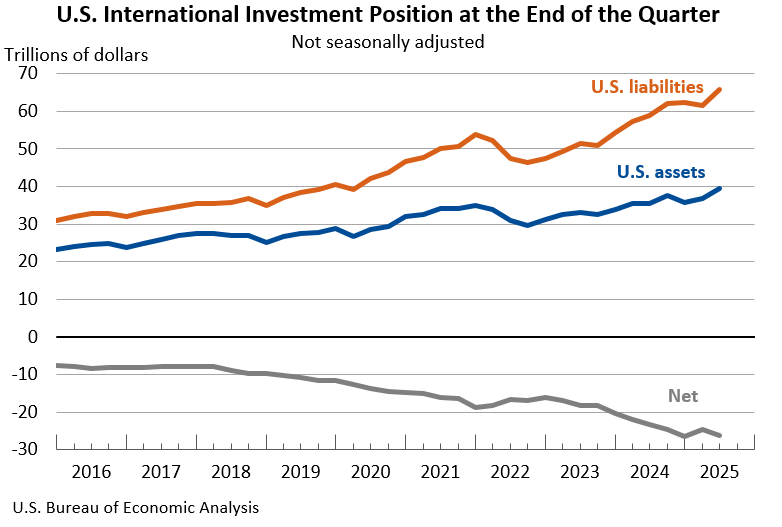Notice
Due to a lapse in appropriations, this website is not being updated.
Bureau of Economic Analysis
U.S. International Investment Position, 2nd Quarter 2025
The U.S. net international investment position, the difference between U.S. residents’ foreign financial assets and liabilities, was -$26.14 trillion at the end of the second quarter of 2025, according to statistics released today by the U.S. Bureau of Economic Analysis. Assets totaled $39.56 trillion, and liabilities were $65.71 trillion. At the end of the first quarter, the net investment position was -$24.65 trillion (revised).
Principal Federal Economic Indicators
Noteworthy
The Latest
Personal Income by State, 3rd Quarter 2021
State personal income increased 2.6 percent at an annual rate in the third quarter of 2021 after decreasing 20.2 percent in the second quarter. The percent change in personal income across all states ranged from 6.7 percent in the Kentucky to –4.3 percent in North Dakota. Personal income estimates reflect the continued economic impacts related to the COVID-19 pandemic. Government pandemic assistance payments to households and business…
Personal Income by State, 3rd Quarter 2021
State personal income increased 2.6 percent at an annual rate in the third quarter of 2021 after decreasing 20.2 percent in the second quarter. The percent change in personal income across all states ranged from 6.7 percent in Kentucky to –4.5 percent in North Dakota.
Real Personal Consumption Expenditures and Personal Income by State, 2020
Today, the U.S Bureau of Economic Analysis released official statistics of real state personal consumption expenditures for the first time. Real PCE decreased 3.8 percent in 2020 for the nation. Across states, the percent change ranged from 2.2 percent in Utah to –7.0 percent in Hawaii, Maryland, and New York; the percent change was –8.9 percent in the District of Columbia. Real state PCE is a state's current-dollar PCE adjusted by the state'…
Real Personal Consumption Expenditures and Personal Income by State, 2020
Today, the U.S Bureau of Economic Analysis (BEA) released official statistics of real state personal consumption expenditures (PCE) for the first time. Real PCE decreased 3.8 percent in 2020 for the nation. Across states, the percent change ranged from 2.2 percent in Utah to –7.0 percent in Hawaii, Maryland, and New York; the percent change was –8.9 percent in the District of Columbia. Real state PCE is a state's current-dollar PCE adjusted…
Gross Domestic Product by County, 2020
Real gross domestic product (GDP) increased in 864 counties, decreased in 2,234 counties, and was unchanged in 14 counties in 2020. The percent change in real GDP ranged from 91.0 percent in Foard County, TX, to –29.0 percent in Skagway Municipality, AK. GDP estimates were impacted by the response to the spread of COVID-19, as governments issued and lifted “stay-at-home” orders. The full economic effects of the COVID-19 pandemic cannot be…
Gross Domestic Product by County, 2020
Real gross domestic product (GDP) increased in 864 counties, decreased in 2,234 counties, and was unchanged in 14 counties in 2020. The percent change in real GDP ranged from 91.0 percent in Foard County, TX, to –29.0 percent in Skagway Municipality, AK.
October 2021 Trade Gap is $67.1 Billion
The U.S. monthly international trade deficit decreased in October 2021 according to the U.S. Bureau of Economic Analysis and the U.S. Census Bureau. The deficit decreased from $81.4 billion in September (revised) to $67.1 billion in October, as exports increased more than imports. The previously published September deficit was $80.9 billion. The goods deficit decreased $14.0 billion in October to $83.9 billion. The services surplus increased…
U.S. International Trade in Goods and Services, October 2021
The U.S. monthly international trade deficit decreased in October 2021 according to the U.S. Bureau of Economic Analysis and the U.S. Census Bureau. The deficit decreased from $81.4 billion in September (revised) to $67.1 billion in October, as exports increased more than imports. The previously published September deficit was $80.9 billion. The goods deficit decreased $14.0 billion in October to $83.9 billion. The services surplus increased $0.…
Gross Domestic Product for Guam, 2020
Real gross domestic product (GDP) for Guam decreased 11.9 percent in 2020 after increasing 2.5 percent in 2019, according to statistics released today by the U.S. Bureau of Economic Analysis. These statistics were developed under the Statistical Improvement Program funded by the Office of Insular Affairs of the U.S. Department of the Interior.
Gross Domestic Product for Guam, 2020
Real gross domestic product (GDP) for Guam decreased 11.9 percent in 2020 after increasing 2.5 percent in 2019, according to statistics released today by the U.S. Bureau of Economic Analysis. The decrease in real GDP reflected decreases in exports of goods and services and personal consumption expenditures. These decreases were partly offset by increases in federal government spending, territorial government spending, and private fixed…




